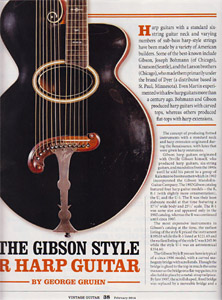
Flipping through the February 2014 Vintage Guitar magazine the other day at the newsstand, I ran across a new piece by George Gruhn on harp guitars; a short feature on a rare early Style R (that Gruhn currently has for sale). He puts it (#4626) at 1906, while I had it placed at c.1905 (as does the Spann book).
Always nice to see him (or anyone) drawing attention to the instrument. It also reminded me how much work Ben (Benoit Meulle-Stef) and I have to do on updating our Gibson section! As so often happens, one thing led to another, and 40 man-hours later, I managed to knock out a fair amount (Ben, you’re up!). Specifically, I starting cleaning up our Gibson Appendix by re-doing all the catalog harp guitar page entries (including all images and commentary), and adding all that were missing. I’m pretty excited about this, as it now includes all catalog information that we (the Gibson research community) currently know of. Thanks especially to Paul Fox and Rod McDonald.
What triggered this complete overhaul?
Reading the Vintage Guitar article, I noticed George’s multiple mention of the “1902 catalog”…which reminded me that I had never posted my discovery about the precise issue date of the famous first Gibson catalog, which for decades I’ve usually seen given as “1902/1903.” While the new Gibson Company may have indeed hit the ground running and immediately began work on the first catalog in October, 1902, the actual “street date” of publication (printing/mailing) was “about the first of February,” 1903, as appears in Gibson’s own text in The Cadenza magazine. I found this out some years ago during my BMG research (photographing 95% of the runs of Cadenza and Crescendo magazines). I subsequently alerted fellow researcher Paul Fox, who included it on his web site, but I don’t know if it’s made the rounds yet.
In any event, I was certainly excited to discover it. Gibson made the announcement in the January, 1903 Cadenza, as seen here:
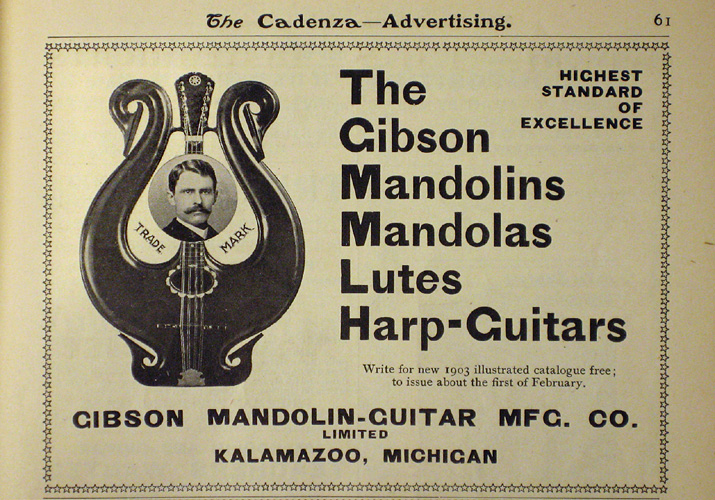
That’s pretty danged specific. Note that they even call it the “1903” catalog. Incidentally, the BMG mags contain other useful and specific Gibson catalog dating clues; all that I’ve found I added to our Appendix. Anyone familiar with the subject knows that the BMG editors quickly became fawning Gibson lapdogs. For example, Catalog “F” was mentioned by Crescendo (Jan, 1909) and The Cadenza even gave it a special headline in their January, 1909 issue:
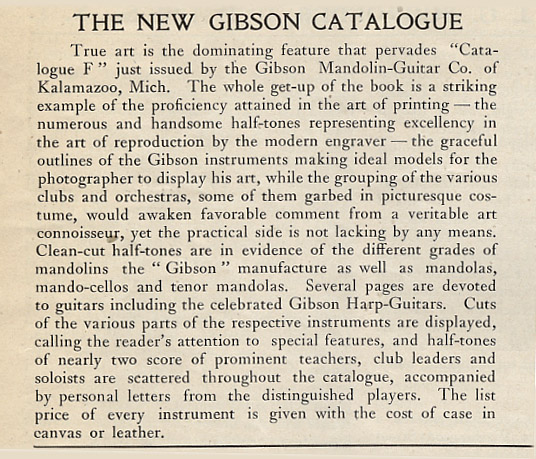 *Note: The editor’s listing of both “mandolas” and “tenor mandolas” is an ignorant mistake, as Gibson only offered tenors (consistently bashing the octave mandola).
*Note: The editor’s listing of both “mandolas” and “tenor mandolas” is an ignorant mistake, as Gibson only offered tenors (consistently bashing the octave mandola).
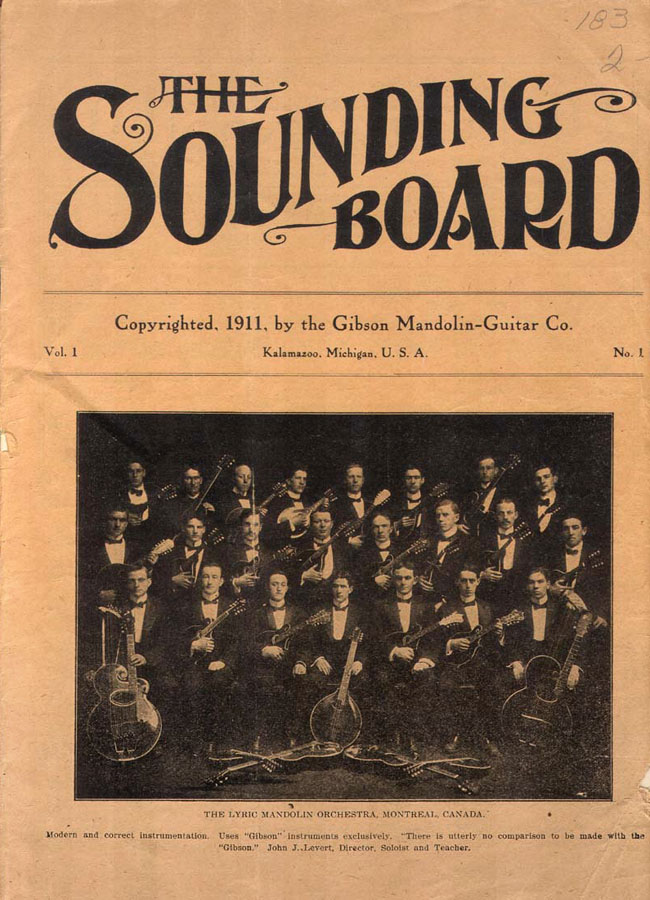
Beyond the important catalog entries, another run of ephemera I would dearly love to add to our Archives is the Gibson Sounding Board (a “house rag” intended for their army of teacher-dealers), of which we have only a couple incomplete examples. If any owners would like to donate additional scans, we would be very much obliged.
While adding/updating the catalogs, I took the opportunity for a quick recheck of the harp guitar models and features during the early years (Ben will add even more detail in the future). This then brought me back to George’s current article:
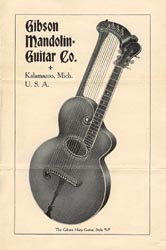
The R (and/or R-1) nominally had six sub-basses; Gruhn’s has seven subs. While rare and wonderful, this isn’t as unusual as it may seem. The 6-bass R/R-1 (regardless of year) is still the version everyone knows as being cataloged by Gibson. However, a key c.1906 “transition period” brochure on their harp guitars ((at right, archived in our Members Only section since 2006) offers 6 or 7 basses for the R. Not only the string count, but the tuning was also transitional. It was no longer F-G-A-B-C-D (nominally – they always acknowledged half step changes for flat keys); instead, it was an abbreviated version of the new 10- or 11-bass system, suggested by the country’s top Gibson harp guitarist, Walter Boehm. As seen in the more common later Gibson catalogs, the eventual “universal” 10-sub-bass tuning has long been known to have been the brainchild of Boehm (who originally played their 12-bass U, as seen in this photo in the January, 1906 Cadenza):
![]()
(Above) Walter Boehm, with c.1905 Style U. Though we know the photo was taken before January, 1909, the Cadenza ad also included Boehm’s testimonial letter to the Gibson Company written on March 25, 1905. This photo may very well have accompanied that letter, putting the instrument (with its small soundhole, geared tuners and plain binding) closer to 1904.
Though Boehm would of course settle on his suggested 10-bass tuning, it’s interesting to see in the transitional brochure how he first applied it to existing Gibson instruments, modifying their stringing slightly to include his high Ab “sub”-bass, whether an R or U strung with 6, 7, 10 or 11 basses. Interesting! (P.S: All known Gibson tunings appear on the general Harp Guitar Tunings page of the site)
But there’s an even more interesting and important stringing arrangement for Gibson harp guitars: the “transitional 9 sub-bass.” As you’ll see in the Gibson Appendix, we think there are still two or three missing catalogs from the early 1900’s out there. Perhaps one of these will have documentation of the 9-bass model. It’s certainly not a “one-off” or an occasional “custom order.” I think I’ve seen as many images of players with the 9-bass as with the original 12 or 6 basses – when I finish collating both extant specimens and historical images, we shall see!
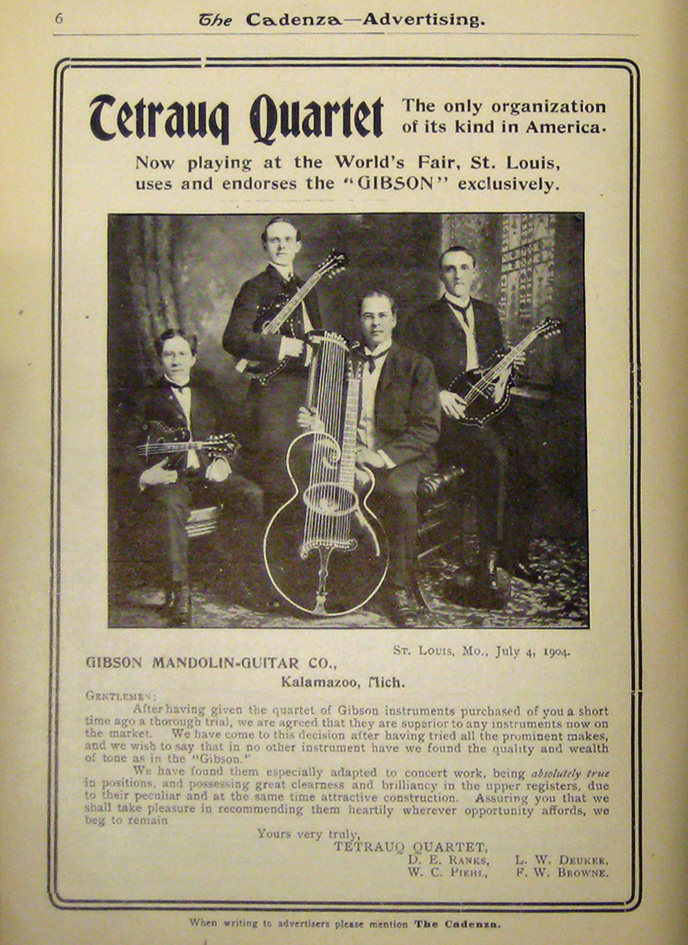
(Above) The first-ever historical photograph of a Gibson player in The Cadenza appeared in the October, 1904 issue. This eye-catching quartet performed at the St. Louis Fair (where Gibson had an exhibit). The “custom” Style U harp guitar (presumably built well before July 4th, 1904, when the photo was taken) has a typical mash-up of features from different “years”: large soundhole, friction tuners, but nine subs and plain ivoroid binding.
Catalogs aside (the R would remain an option only for another year, leaving only the 10-bass U, in scroll bridge, then floating bridge versions), as far as actual specimens – whether extant instruments or those seen in old photographs (of which we have hundreds that include Gibsons) – at this stage of the game, we’ve seen every consecutive count of sub-basses on Gibson harp guitars (most often the early ones) – configurations that include 6, 7, 8, 9, 10, 11 and 12 sub-bass strings.
All of which (to me) just makes tracking and researching these iconic instruments all the more fascinating and fun!

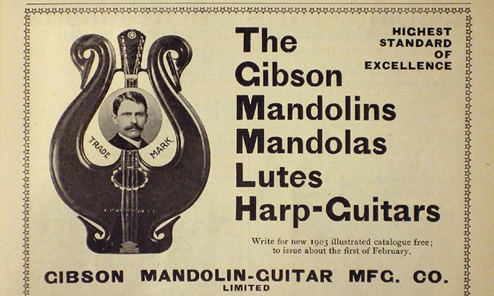
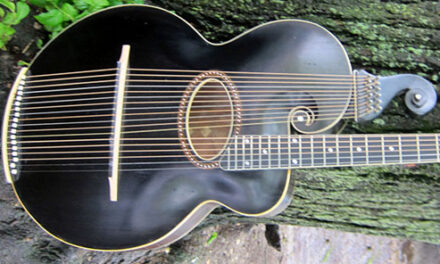
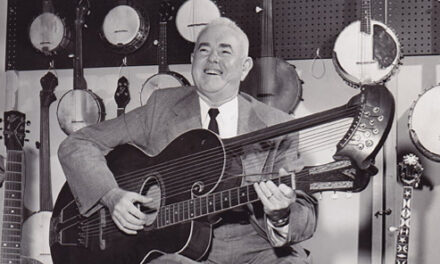
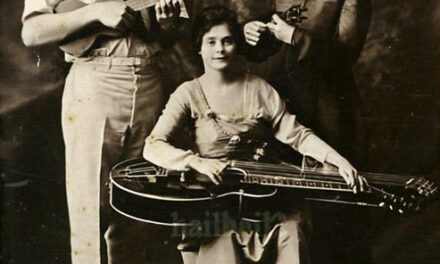
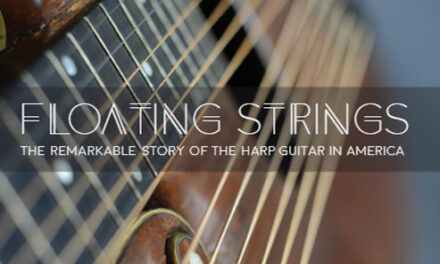
Phil – let’s continue this very interesting conversation privately (or move to Forum). I don’t want to answer too casually and need more research time.
However my 1903 Style O guitar has friction tuners.
Mine is a first year R with original geared tuners. I have never seen one with friction tuners. Have you?
Thanks, Phil. Yes, main strings (which lasted only a year or so); the subs were always friction tuners (no knobs; clock key required).
Great post! Towards the end of it you mention friction tuners. Are you referring to the tuners on the guitar head or the harp strings?
Michael – we hope to address (among so many questions) the tension bar (by “address,” I mean show and discuss and not “solve”!). My guess right now is that some were modified afterwards (we’ve seen many old instruments with “new” features and vice versa. And as my PDF (J) shows, an owner could easily purchase and add a tension rod and all manner of extra new harp guitar parts to customize their old Gibsons…
I don’t like to get into value other than when I list at HGM. Like yours, this has a top refin (it once had an added pickguard which had to be addressed).
Ok, I saw the price..seems quite fair to me. Mine is not entirely original but it plays and sounds great. If I could get half that price or more I might sell my R some day.
My Gibson R does not have the neck adjustment bar shown in your link. It also said “The Gibson” on the head stock. I guessed it was 1906. I am not able to read the serial number. Do you know what price Mr G is asking for his R?